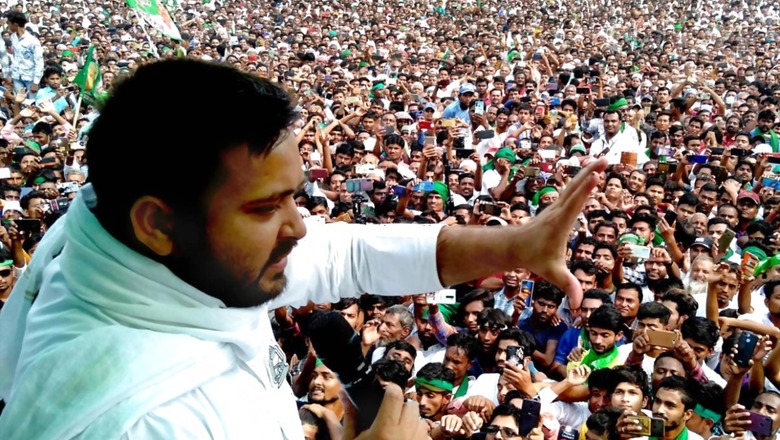
views
The politics of Bihar changes every 15 years. A trend visible in the iconic Jayprakash Narayan movement is again taking shape in this year’s Bihar elections. For the first time in more than three decades, youth is emerging as a caste-agnostic constituency for a state leader.
While the Lalu-Rabri duo ruled the state for 15 years and Nitish Kumar took over from 2005 to 2020, Bihar’s youth seems to have voted for ‘badlaav’ (change) rising above the caste matrix.
“I am a Rajput. In 2010 and 2015 I was with the BJP. But this time I am rooting for Tejashwi Yadav. We want to remove Nitish Kumar. We are young and will obviously think about the youth. We want jobs. It’s been two years since I applied for a job at NTPC. It’s been long since I also appeared for state service commission exam,” said a young voter at Mahatma Gandhi Central University in Motihari in East Champaran which is known to be a saffron bastion.
At almost every rally that Rashtriya Janata Dal (RJD) leader Tejashwi Prasad Yadav attended, huge crowds of young men followed him in a wave. The 31-year-old seems to have driven home his promise of 10 lakh government jobs. He often repeated, in his rallies, that he will sign on his promise of jobs the day be becomes chief minister.
The RJD appears to have done the math behind it as well. The party has claimed that there are 4.5 lakh pending vacancies in the Bihar government already and another 5.5 lakh jobs need to be created.
The promise has found resonance among the youth, especially in a state where lack of employment is one of the biggest drivers of migration. The unemployment rate in Bihar was at 10.3 per cent last year and ranked among the highest in the country. According to CMIE, the state’s unemployment rate increased by 31.2 percentage points, rising to 46.6 per cent in April 2020, almost twice the national average.
The 64th round of the National Sample Survey stated that around 30.7 per cent of the total out-migrants from Bihar moved in search of employment as they could not find work.
Added to this is the fact that Bihar is India’s youngest state, according to Census 2011. And projections opine that its median age will be under 30 even 16 years from now, when the median age of India hovers around 34.7 years. According to Census 2011, Bihar’s median age currently stands at 20 years.
It was only for Prime Minister Narendra Modi that the youth had emerged as an undivided constituency in 2014 and 2019. It is for the first time that this trend is being repeated for a state leader.
Bihar’s youth has not been a close spectator to policy-level changes related to caste. On August 7, 1990, then PM V P Singh announced in Parliament that his government had accepted the Mandal Commission report, which recommended 27 percent reservation for OBC candidates at all levels of its services.
This young constituency also has no lived memories of what the BJP-JD(U) termed as the ‘jungle-raj’ to attack the opposition pointing towards the Lalu-Rabri regime.
For young voters, this election is very different from the recent ones they have witnessed, which is why the shift towards Tejashwi came about only after arguments between different generations.
“For the last 15 years Nitish Kumar has been saying the state needs special status. I can’t believe he doesn’t have a plan for the state. He has said Bihar is landlocked, there is no sea near the state so he can’t develop and there cannot be any jobs. Then what has he been elected for? Such is the state of education in Bihar that a three-year undergraduate course gets completed in 6 years, we don’t get degrees on time,” said another young voter in Bihar’s Maner Sharif.
Nitish’s image of ‘Susashan Babu’ also seems to have become stale in the eyes of the young voter. As part of a welfare scheme, in order to promote education and safety, he had provided cycles to young girls throughout the state but even that seems to have proved wanting of direction and further vision.
“The state has somewhat developed but Bihar has still not been able to achieve its desirable potential. Roads and electricity are there on the priority list but our education is not taken care of. We don’t believe in this double-engine government. Nitish Kumar gave us cycles but now what lies ahead? The government must change,” said a girl student of LN Mithila University in Darbhanga.
This is exactly where Tejashwi Yadav appears to have cashed in. He was quick to learn that Lalu Yadav’s call for secularism and social justice was not relatable to the post-Mandal, post-Babri generation. Therefore the clarion call for jobs. He also promised pay parity to over five lakh contract teachers along with raising salaries for aanganwadi and ASHA workers.
The extent of job distress in Bihar maybe gauged from the fact that a young voter in Nitish’s rally said, “I am a post graduate degree holder and I have not been able to find a job for the last seven years. I keep going to state offices in search for a job but have always been turned away.”
Bihar is seeing the rise of an aspirational vote which wants more than just ‘bijli, paani aur sadak’. That is where Nitish Kumar, despite putting the state on the track of development, seems to have lost connect with the young Biharis.
Read all the Latest News, Breaking News and Coronavirus News here

















Comments
0 comment